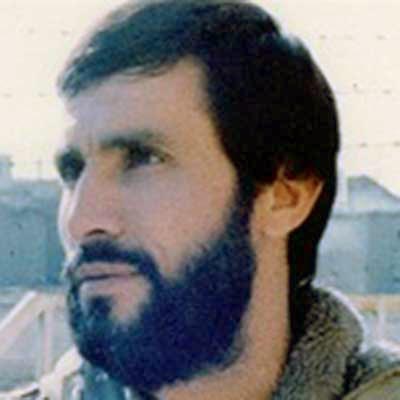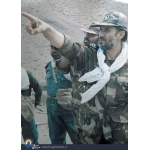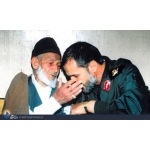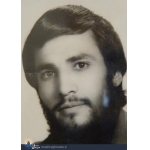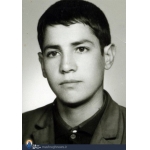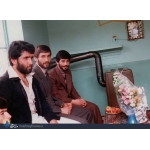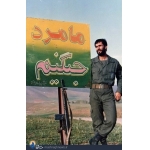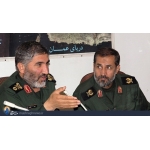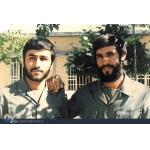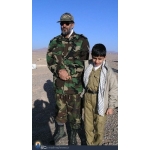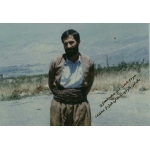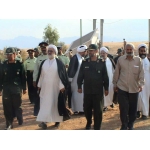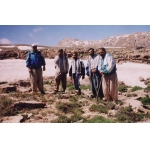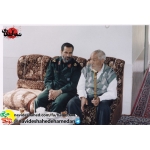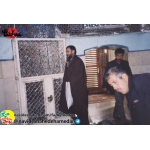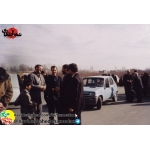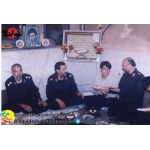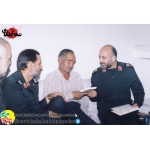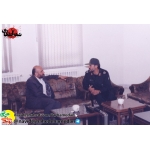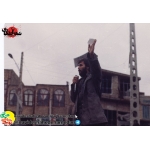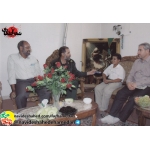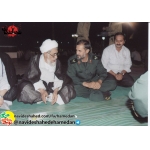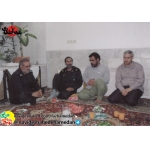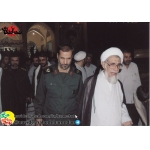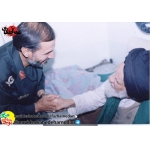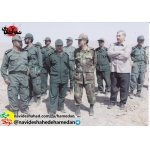Qahari-Saeed, Saeed
Milad Shoiklo
275 بازدید
Saeed Qahari-Saeed (1952-2006) was one of the commanders of the Islamic Revolutionary Guard Corps (IRGC) during the Iran-Iraq War. He is known for his battles and operations against the Democratic Party of Iranian Kurdistan, the Komala, and anti-revolutionary groups. While serving as the commander of the 3rd Hamzeh Seyyed al-Shohada Division, he was martyred in clashes with the PJAK group.
Saeed Qahari-Saeed, son of Hossein-Ali, was born on March 25, 1952, in the village of Chenar Olya in Asadabad County, Hamadan Province. He completed his elementary education in the same village and later moved with his family to Hamadan. Alongside his studies, he pursued Quranic sciences under Ayatollah Molla Ali Hamadani. In 1972, he went for his military service. During 1975 and 1976, he became involved in revolutionary gatherings and participated in activities alongside prominent clerics and other revolutionaries of Hamadan. After the victory of the Islamic Revolution, he joined the Islamic Revolutionary Committee after its establishment. In 1979, with the cooperation of several revolutionary forces, he helped establish the Islamic Revolutionary Guard Corps (IRGC) in Hamadan.
In 1979, Qahari-Saeed went to Paveh to help liberate the city from the siege of the Komala and Democratic Party forces. He fought alongside Mostafa Chamran until the city was completely liberated. In that same year, following the decree of Imam Khomeini to establish the Basij of the Mostazafin (impoverished), he was tasked by the IRGC officials to organize and establish the Basij unit of the Hamadan province. Within six months, he succeeded in recruiting around 20,000 people for the Basij, including 5,000 women.
In 1980, after the formation of the Basij, he was appointed commander of the IRGC in Nahavand. This new responsibility coincided with the start of the Iran-Iraq War, and he also took on the role of supporting the forces on the Dezli-Mariwan front. In 1982, at the insistence of Mohammad Boroujerdi, commander of the IRGC Region 7, he stepped down as Head of the IRGC in Nahavand. Due to the extensive presence of anti-revolutionaries in the Senqor-Koliai region, which was geographically significant and provided easy access to the Hamadan and Kermanshah provinces, he was assigned the responsibility of liberating that region.
Using local forces and his experience, he was able to monitor the anti-revolutionary movements, establish the 207th Shahid Beheshti Battalion, and set up several operational bases through independent companies. As a result of his efforts and those of his forces, lasting security was established in the region.[1]
In December 1983, during the planning of "Labbaik Ya Khomeini," Saeed Qahari-Saeed, alongside a group of Basij and IRGC forces from Senqor, was deployed as part of an operational brigade to the Changuleh region. In February of that same year, he participated in Operation Valfajr 5, serving as the Head of Staff of the Al-Zahra Division.[2]
In January of 1985, Qahari married Farahnaz Rasouli, daughter of the village chief of Mikhuran in Senqor, who had recently moved to Senqor. This was Qahari's second marriage; he had a one-year-old son named Abbas from his first wife.[3] His second marriage resulted in two daughters, Bentolhoda and Fatemeh, and a son named Ahmad Hassan.[4]
At the end of 1984, given the IRGC's mission to establish lasting security in the Kurdish regions, Qahari was assigned the responsibility of securing the Javanrud region as that region’s commander of the IRGC. Drawing on his previous experiences in the Kurdish areas, he managed to ensure security in the region, creating the conditions for the local population of liberated areas to join the Abuzar Defensive Brigade and organizing them into defensive battalions.[5]
In January of 1987, he took part in Operation Karbala 5. During this operation, he deployed battalions of local forces to the southern region. Qahari was wounded several times during this operation.[6]
After recovering from his injuries, by the order of Mostafa Izadi, the commander of the IRGC Ground Forces, Saeed Qahari-Saeed was appointed as the Commander of the Paveh IRGC. In the meantime, he retained his command over the Javanrud IRGC and the Abuzar Brigade. During his tenure in these units, he led dozens of offensive operations against the Democratic Party of Iranian Kurdistan and Komala forces in the border areas shared with Iraq. In March 1988, he also participated in Operation Valfajr 10.[7]
In June of 1988, he went to Tehran to attend the Third DAFUS (Command and Staff College) course of the IRGC. In August of that same year, he took part in Operation Mersad and then returned to Tehran to resume his DAFUS classes.[8]
After completing a one-year course, Qahari was offered one of the managerial positions at Imam Hossein University. However, under the orders of Mostafa Izadi, he returned to the western region and accepted the deputy command of the 4th Ansar al-Rasul Brigade in the Oramanat region. After four months, he was appointed Commander of the IRGC in Marivan.[9]
As commander of the IRGC in Marivan, Qahari succeeded in activating and operationalizing 30 percent of the region's bases within a year by utilizing local forces. By activating 80 operational bases and organizing 2,000 personnel, he designed and carried out several operations against anti-revolutionaries in the border and cross-border regions, including "Jomh-Ressi" and "Darah Shiler" in Iraq.[10]
In 1991, during the Iraqi uprising, Qahari was assigned as a representative of the Hamzeh Seyyed al-Shohada Headquarters, and with the approval of the regional security council, to manage border control and oversee the reception of Iraqi Kurdish refugees.[11]
During his command of the IRGC in Marivan, he managed to capture and dismantle groups from the dissolved Democratic Party of Iranian Kurdistan and Komala on two occasions. One such operation resulted in the destruction of a group led by Tofigh Elyasi and Abdullah Nejmari, two high-ranking Komala members, in the village of Bardeh-Rash.[12]
In the latter half of 1991, Saeed Qahari-Saeed was appointed as Deputy Commander of the Shahid Shahrumfar Base in Sanandaj. In mid-1992, he was transferred to Urmia, where he became the commander of the cross-border Shahid Kaveh Base.[13]
In 1993, while retaining his position as commander of the Shahid Kaveh Base, he was appointed deputy commander of the 3rd Al-Mahdi Division. However, he soon relinquished his role at the Shahid Kaveh Base.
One of Qahari-Saeed’s key missions occurred in 1994, during a confrontation with anti-revolutionary forces in the city of Oshnavieh. During this mission, many insurgents were killed. Qahari was wounded in this operation and hospitalized for two months. His injuries were so severe that he required six months of medical leave, but he returned to work before completing his full recovery period.[14]
Until 1995, in addition to his command of the 3rd Al-Mahdi Division in Urmia, Saeed Qahari-Saeed also held the responsibility of inspector for the Hamzeh Seyyed al-Shohada Base. In 1995, he became the coordinating deputy of the base.[15]
In 1998, while serving as the coordinating deputy of the Hamzeh Base, he was appointed commander of the Shahid Shahrumfar Base in Sanandaj. He divided his time by spending three days in Sanandaj and four days in Urmia.[16] In 2001, he was appointed deputy commander of the Najaf Base in Kermanshah. On July 20, 2004, he was appointed commander of the 18th Al-Ghadir Brigade in Yazd. During his time in Yazd,[17] he had the opportunity to engage in cultural activities and founded the Congress of Martyrs of Dar al-Ibadah Yazd.[18]
On November 13, 2006, he became the commander of the 3rd Special Division at the Seyyed al-Shohada Base,[19] once again relocating to Urmia. Upon his arrival, he immediately began planning operations to clear volatile areas and combat the anti-revolutionary forces.[20]
During this period, the PJAK group sent a letter threatening him and his family. Despite being eligible for retirement, Qahari ignored the anti-revolutionary threats and continued his mission.[21]
On February 21, 2007, Saeed Qahari-Saeed set out for the Salmas region to execute an operation that had been planned for a long time.[22] Two days later, he and 14 of his companions were martyred in Hell Valley Heights, near the Iran-Turkey border, during a clash with PJAK militants and insurgents. After two days, his body was found by the Saberin Battalion commandos and some of the locals. His body was then transported to Urmia. Following a funeral in the city, his body was taken to Hamadan. On March 1, after a funeral procession, Saeed Qahari-Saeed was buried alongside twelve unknown martyrs in the Behesht Mohammadi Cemetery in Hamadan.[23]
One of Qahari-Saeed’s notable traits was documenting the events of his service. After his martyrdom, Mohammad Rasoul Rostami, the son of one of Qahari’s friends, collected and compiled his memoirs, reports, and notes, which were published by Soore Mehr in 2016 under the title Saeed's Notes.[24]
In 2017, Saeed Qahari-Saeed was recognized by the Ansar al-Hossein Corps as one of the prominent martyrs of Hamadan Province.[25]
[1] Rostami, Mohammad Rasool, Yaddasht hay Saeed (Saeed's Notes), Tehran: Surah Mehr, 2nd edition, 2018, pp. 20-26; Behzad, Hossein; Babaei, Gol Ali, Hampay Saeqeh (Companion to the Lightning), Tehran: Surah Mehr, 2000, p. 802.
[2] Rostami, Mohammad Rasool, Yaddasht hay Saeed (Saeed's Notes), p. 25.
[3] Khezri, Farhad, Hamsafar-e Atash Va Barf (Companions of Fire and Snow): Farahnaz Rasouli's Narration of Saeed Ghahari-Saeed, Tehran: Revayat Fateh, 2014, pp. 11, 37, and 44.
[4] Ibid., pp. 66, 71, and 114; Rasouli, Farahnaz, Ashenay Qarib (Strange Familiar): The Biography of Martyr Qahari as Narrated by His Wife, Tehran: Arman Baratha, 2012, p. 69.
[5] Seyyed Mohammadi, Seyyed Abu Talib, Sarbaz-e Khaki-e Velayat: A Narrative of the Life of the Martyr General Haj Saeed Qahari-Saeed, Tabriz: Yas Nabi, 2011. pp. 22 and 23.
[6] Ibid; p. 23.
[7] Rostami, Mohammad Rasool, Yaddasht hay Saeed (Saeed's Notes), p. 29.
[8] Khezri, Farhad, Hamsafar-e Atash Va Barf (Companions of Fire and Snow), pp. 101 and 102.
[9] Seyyed Mohammadi, Seyyed Abu Talib, Sarbaz-e Khaki-e Velayat (the Modest Soldier of the Province), p. 25.
[10] Rostami, Mohammad Rasool, Yaddasht hay Saeed (Saeed's Notes), p. 30.
[11] Ibid; p. 31, Khezri, Farhad, Hamsafar-e Atash Va Barf (Companions of Fire and Snow), p. 114.
[12] Rostami, Mohammad Rasool, Yaddasht hay Saeed (Saeed's Notes), p. 33.
[13] Rasouli, Farahnaz, Ashenay Gharib, pp. 55 and 56
[14]Bagheri Hassan, Akharin Ma'amoriat (The Last Mission): An Analysis of Three Decades of Struggle of the Tireless General, Brigadier General of the Revolutionary Guards, Martyr Saeed Ghahari-Saeed, Tabriz: Akhtar, 2017, pp. 24 and 25.
[15] Ibid; p. 26.
[16] Ibid; p. 26.
[17] Rostami, Mohammad Rasool, Yaddasht hay Saeed (Saeed's Notes), p. 39.
[18] [18]Bagheri Hassan, Akharin Ma'amoriat (The Last Mission), p. 26.
[19] Rostami, Mohammad Rasool, Yaddasht hay Saeed (Saeed's Notes), p. 39.
[20] Khezri, Farhad, Hamsafar-e Atash Va Barf (Companions of Fire and Snow), p. 243.
[21] Ibid., pp. 245-247.
[22] Ibid., p. 259.
[23] Ibid., pp. 259, 267, 274, 275, and 282.
[24] Rostami, Mohammad Rasool, Yaddasht hay Saeed (Saeed's Notes), pp. 4, 7 and 8.
[25] Kayhan Newspaper, No. 21589, April 3, 2017, p. 7.


